A digital conversation space that inspires and activates participants
Environmental vision

In June 2020, the municipality of Utrecht faced the challenge of organizing an environmental vision for the Kanaleneiland and Transwijk (NL website) together with residents while the Corona crisis made it impossible to meet physically.
In the search for a suitable solution, Lars Schotel, senior advisor in various Utrecht participation projects, booked a QandR demo. He saw how QandR can help participants in a fun, accessible way to simultaneously provide input (parallel to each other) during an online group meeting. The workshops they were planning were to cover various topics, and the diversity of (easily operated by telephone) interaction forms (modules) that QandR offers might well fit in nicely.
We were looking for a tool that smartly supports a good digital conversation. That easily takes stock of opinions, but also gives room to a more in-depth discussion. The intuitive and visual aspects of QandR stood out. It does collect responses to questions but most of all provides the space for discussing them. Including the option to use images as responses. QandR also seemed like something everyone gets (which turned out to be correct).
Lars Schotel, senior advisor to the municipality of Utrecht
The tool should be GDPR compliant
An important requirement for all tools that the municipality of Utrecht uses is that the privacy of the participants in a session is guaranteed. Fortunately, QandR has been developed in such a way that people participate in sessions without having to register. QandR does not require any kind of personal information (not even a nickname). A participant taps a link on his or her phone and then enters a code, after which he or she can immediately participate in the session. The system itself does not know anything about the participants, first or last name and phone number remain unknown to QandR. This was a conscious choice in the development of the product. The GDPR states that great care must be taken with personally identifiable information. By choosing not to request or store this information at all, privacy is maximally guaranteed.
When the privacy guarantee was clear, the municipality of Utrecht was able to approve the use of QandR and they have now used the tool for several projects such as discussions on the environmental vision and the energy transition. These online meetings were always held in the evening from 20:00 to 21:30 and in this use-case description we would like to discuss a number of examples.
Visuals are starting point of the conversation
Below are two screenshots from the Greenery workshop on 9 June, in which with 24 participants more nuance was sought in the different types of greenery that can be added to their neighbourhood. They were able to explain their ideas by means of an aerial photo in which they could indicate where they would like to see more greenery. By moving a dot on a trackpad on their phone, participants saw their dots move directly on the main screen and were able to point to the correct spot. A unique feature of QandR that stimulates intuitive responses.
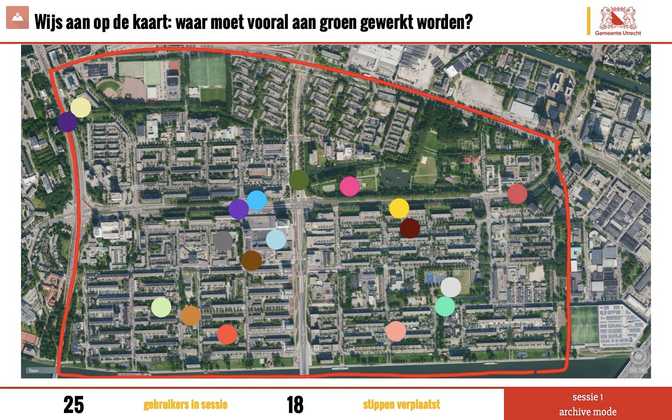
Next, a wordcloud was used to discuss nuances in the type of green they would like to see.
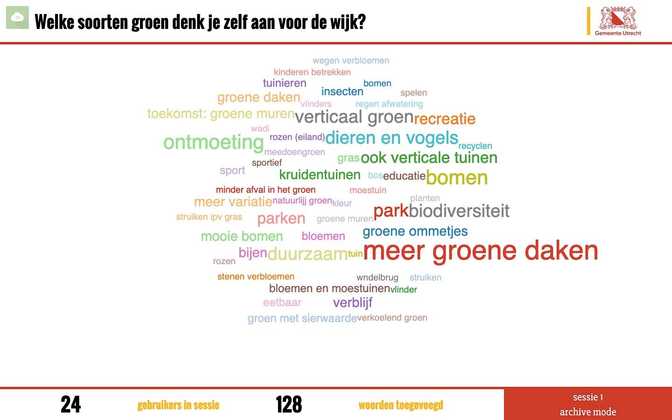
Both the aerial photo with pointers and the word cloud served as starting point for the conversation. Participants involved themselves in the topic by submitting places and ideas via their phone, which the moderator subsequently discussed in detail, giving different people the opportunity to verbally explain their points of view.
Visual and playful via moodboards
The June 16 workshop focused on young people. How do young people currently experience the district, and how can the municipality involve them in the future plans for it? The grading (score) clearly showed, with an average mark of 4.5, that the 22 participants overall felt that the current district has too little to offer for young people.
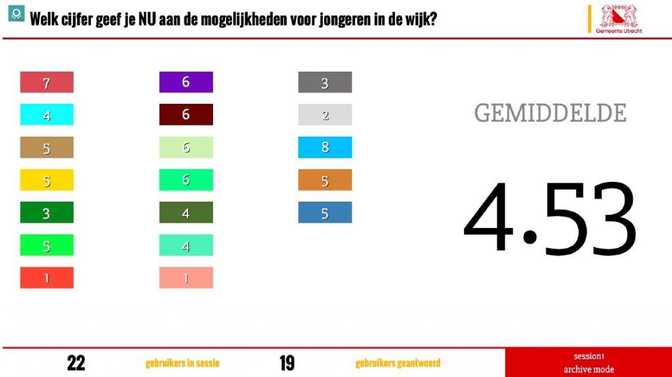
Although the individual grades and the average are quantitative figures, that is not the essence of this module. The point is that the facilitator quickly sees which figures are being given and can then use the colours (that participants keep throughout the session) to ask participants to explain their assessment qualitatively. The next step in this workshop of the municipality of Utrecht was to query participants via a Wordcloud about the (negative) effects of the lack of good facilities, which quickly demonstrated the urgency of the issue.
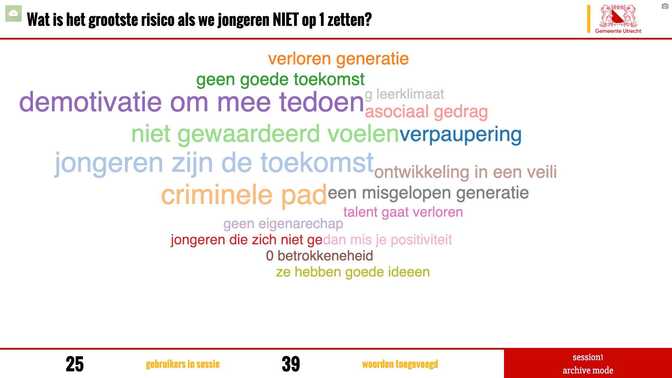
In the search for solutions, the moodboard below asked these young people what they like to do most when they are outdoors.
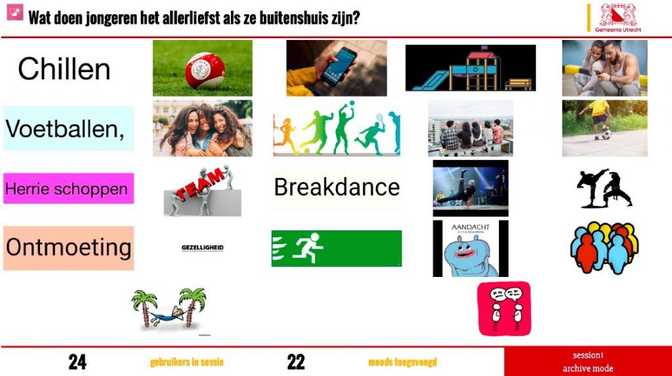
The visual power of the moodboard was beautifully reflected in the sign of an emergency exit that was submitted. The explanation from the participant concerned showed that going out of the house often has to do with fleeing living conditions indoors, which are not always good. Most of the houses in this district are quite small whilst housing large families, with perhaps 6 family members.
This search for concrete facilities or services that the municipality can actually offer was further explored in the wordcloud below.
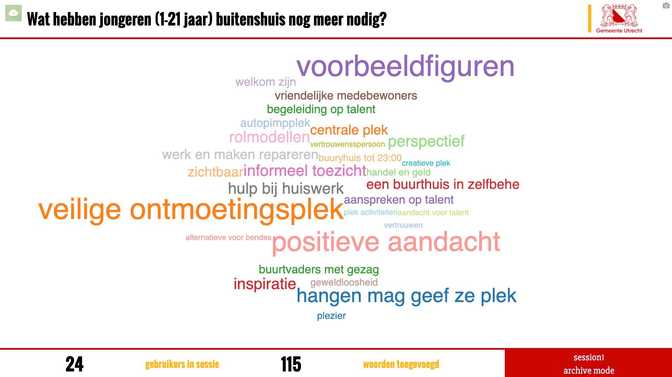
In the wordcloud, a number of words are very large because many participants in the meeting upvoted these (in addition to submitting your own words, you can also upvote words from other participants in QandR, that then increase in size). Role models were considered important by participants, and a place to hang out, such as a self-managed community center, is something that is currently missing and needs to be added.
Not a matter of black or white
In an earlier stage, during a meeting in early March, which was still physically organized, residents of the district had indicated that they would like to be 'Proud' of their neighbourhood once again. During the online workshop on June 16, the topic 'Pride in the neighborhood' was examined further. What exactly do residents mean here? What forms of Pride are there in practice? And how can the municipality respond to this in its zoning plan, for example when setting up the Roosevelt Boulevard, where there are opportunities to offer extra facilities? Whether the neighbourhood is already a neighbourhood to be proud of was discussed on the basis of the dilemma below, in which participants could take their position by placing their dot on an axis with on the left 'Have we already done each other' and on the right 'Must happen a lot.' Not only did this show how divided opinions are on this issue, it was also clear that participants saw different nuances. In the discussion that followed participants could explain their own perspectives.
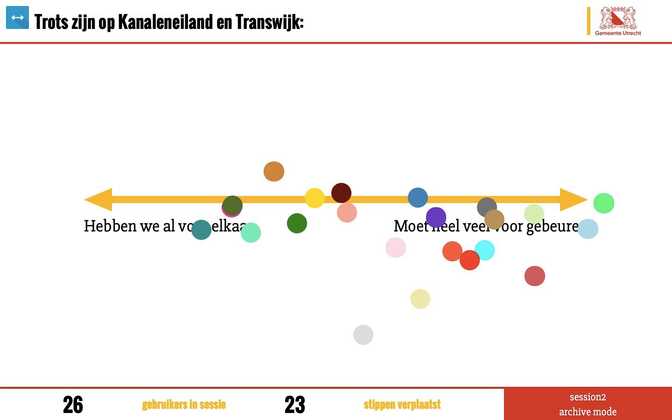
Compared to the classic multiple choice question (poll), the dilemma (pointer on an axis) has the advantage for participants that they are not forced to make a black and white choice, but can also position themselves, say, somewhere to the right of the middle. The explanations that participants gave afterwards therefore contained more nuanced arguments, in which both reasons for pride and concern were expressed. It is pleasant for the facilitator that the dilemma immediately provides a visual overview of the points of view, so he can, for example, allow someone from the left spectrum to speak first and then someone who is more on the right.
Exercising real-time influence
The nice thing about QandR is that the visuals remain influenceable during the time that the subject is discussed. In the case of a dilemma, for example, this means that if someone gives very good arguments for a certain position, you can also see the dots react to this. This direct 'live' interaction gives participants the feeling that they exercise direct influence on the conversation. This creates a completely different experience from other systems, where participants get the feeling that they are completing a kind of survey, with their response emerging somewhere later in the process, along with the answers of all participants. QandR distinguishes itself by the real-time interaction with the phones. This applies to all modules, but is most powerful with the pointer modules (such as pointing to a map or the dilemma above). Every movement with the participant's finger on the phone immediately changes, visible to everyone, the position of their dot (pointer) on the main screen. This direct interaction gives participants much more the feeling that they are really 'in control', that they directly determine the content and thus also have a clear say in the conversation.
We were also looking for a tool that gives such a digital conversation space and inspires and activates participants. This space is created, for example, because people can also place the dot between pictures, and in that way say something that differs from what we had programmed. Activation arises from the digital 'bodyvoting' and 'deep democracy' that are possible by working with the dot. Precisely the fact that answers are never final evokes action from the participants. You can see from the movement of their dot during the conversation that they influence each other, change their, and come up with new ideas.
Lars Schotel, senior advisor to the Municipality of Utrecht
The ease with which you as a facilitator get the conversation going is reflected in the variant of the pointer below. Instead of a map or aerial photo, participants were able to discuss the subject of 'pride in their neighbourhood' via a collage of photos of buildings, with the facilitator discussing the role that architecture and maintenance play in the degree of 'pride' on'. What is striking in the screenshot below is that the vast majority of participants chose to designate an existing complex that has recently been renovated. The explanation of this choice showed that since the renovation, the entire neighbourhood has been treating their physical living environment with more attention and care, in the sense that people now also invest in beautiful plants in their garden and a street that remains clean. During the workshop, this topic turned out to be many times more relevant than building a grand prestigious building, such as the one depicted with the tower at the bottom left.
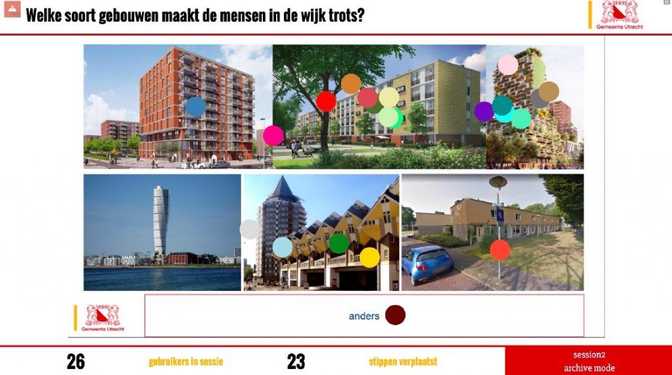
The above pointer is also a good example of the visual and playful character of QandR, which makes it easier for participants to express their own points of view. The fact that QandR does not put participants in boxes is nicely illustrated by the participant with the pink pointer in the screenshot above, who clearly chooses to touch both photos. In her explanation she indicated that both photos attracted her in a certain way and that she did not want to make a choice. The fact that this does not necessarily has to be done in QandR, and that you can also move more subtly across an axis in a dilemma, does justice to the complexity of reality.
Conversation with room for nuances
The examples illustrate that with QandR, even if the group is somewhat larger, the dialogue can retain the character of a qualitative and substantive conversation, which also has room for nuances. This power of nuance embedded in QandR has its origins in the genesis of the tool. QandR was originally developed to facilitate qualitative research where nuanced discussions are essential to generate the right insights. See, for example, our partner Motivaction, who already used QandR well before Corona during focus group discussions in its qualitative market research. We are pleased to see that during this crisis more demand has arisen in the field of citizen participation. But we hope that these new partners also realize that QandR is not only suitable for online sessions, but that the technology can also be used with a large screen and smartphones in a neighbourhood venue. Or in a hybrid way, both on location and remotely. Noterik is exploring those options and we will update you on this in a future news item.
Back to the use case at the municipality of Utrecht. In its zoning plan, the municipality has room for new facilities, such as the layout of the Roosevelt boulevard that runs along the Merwede canal. In the moodboard below, participants were asked what kind of activities they would like to see there.
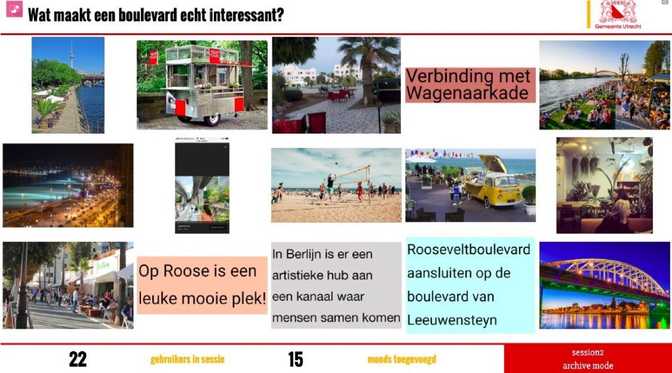
Some participants used the most obvious function to search for pictures on the internet, but others went for the other options, such as uploading photos from the phone or sending short texts, without additional instruction.
Easy of use
The way in which participants gave suggestions for Roosevelt Boulevard via pictures shows QandR's ease of use. Where many online tools are more suitable for professionals, the various QandR modules make it easy to engage in conversation with non-professionals as well. Whether you use the pointer to point at something, or create a moodboard together, QandR makes it easy with a telephone interface that is also understood without a professional background or additional explanation. The fact that participants of the online workshops appreciate this working method was also nicely reflected in the two closing questions that are asked at each workshop. See below for the answers of the workshop Green, held on a Tuesday evening in June.
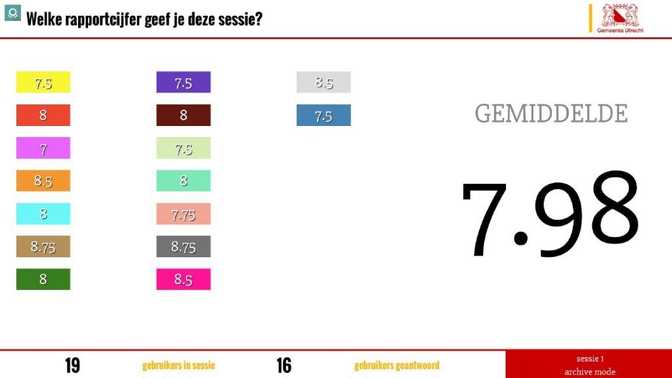
This is how participants rated their experience individually and as a group. Finally, in an open wordcloud question, participants were able to give their suggestions for the upcoming workshops.
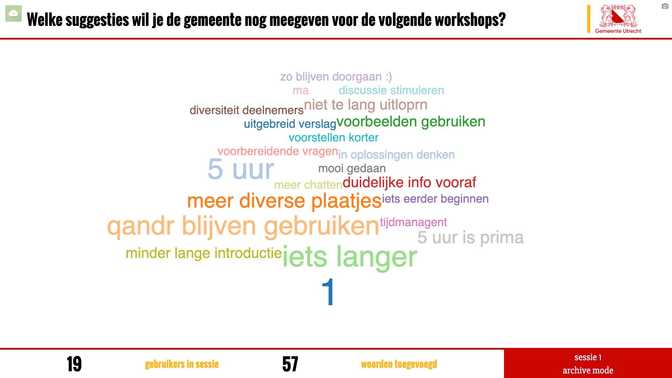
City Talk on New Energy
The sessions around the environmental vision were so successful for the municipality of Utrecht that they purchased a QandR subscription, which since then has been used for several sessions. An impressive project was the City Talk on New Energy, which took place in January 2021. In this, a total of 11 sessions were organized with a total of 235 different participants.
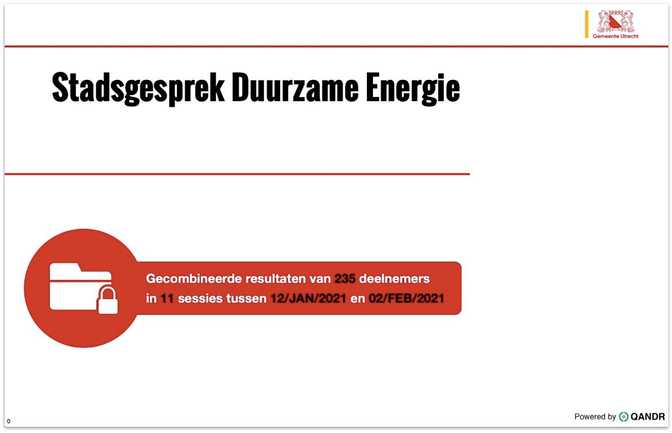
In the 11 sessions of the New Energy City Conversation, different stakeholders were heard about the rules of the game that they consider important when realizing plans around new energy facilities for the city. Download here a pdf in which the results of all these sessions have been compiled.
Would you like to give QandR a try?
Would you like to experience how QandR works? Then book a free demonstration. If you just want to get started right away, request a facilitator's account.